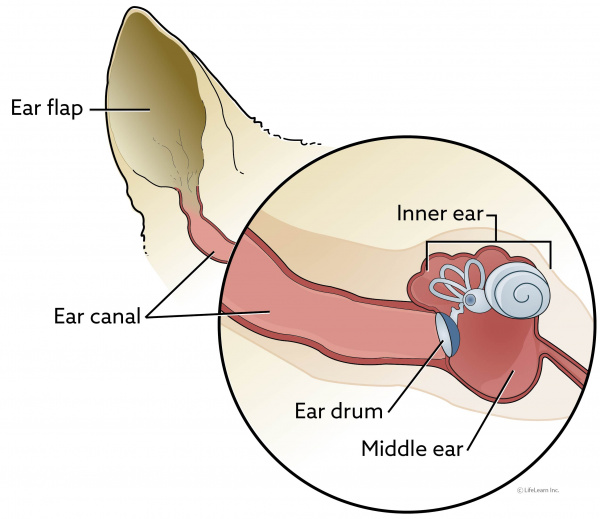Arual Hematoma Is the Ear Ever Right Again
What is a hematoma?
A hematoma is a localized mass of blood that is confined within an organ or tissue. A hematoma is sometimes referred to as a blood blister. The most common type of hematoma in the dog is that affecting the pinna or ear flap. This is called an audible or ear hematoma.
Why do aural hematomas occur? 
Ear hematomas occur when a claret vessel in the ear bursts and bleeds into the space between the ear cartilage and peel. This is most commonly associated with trauma such as scratching, shaking the ears, or bite wounds. Dogs with ear infections may violently shake their head or scratch their ears causing an aural hematoma. In some cases, there may be a piece of foreign material lodged in the ear canal, such equally a tick or piece of grass. It is also possible that a foreign body initiated the shaking just was after dislodged.
Dogs with long, floppy ears are at greater gamble for developing ear hematomas. Pets with clotting or bleeding disorders may also develop hematomas, with or without a history of trauma.
How is a hematoma treated?
The hematoma must be treated equally before long as possible or permanent disfigurement may result.
"The hematoma must be treated equally soon as possible or permanent disfigurement may result."
The preferred method of handling involves surgical correction of the hematoma. The actual surgical technique varies with the private circumstances and veterinarian's preference, simply always involves the same basic steps. First, the skin over the hematoma is surgically incised to bleed the blood and remove any claret clots. Next, the empty space (called dead space) is removed by placing numerous sutures through the ear, which will promote controlled scar tissue formation, reattaching the cartilage to the skin, and helping foreclose future recurrence. A surgical drain may be placed to promote drainage. Finally, the pinna is supported to minimize further damage and promote healing. It may be supported by a bandage or other material practical directly to the ear, or past bandaging the ear against the caput.
Also as treating the hematoma, it is important to care for the underlying crusade, which in many cases is an infection or allergy. Once the hematoma has been surgically corrected, if an underlying crusade of the ear trouble is found, such as an infection, an allergy, or a foreign torso, it will be treated.
What follow-up treatment is needed? 
Drainage tubes or bandages may be removed by your veterinarian after iii-14 days. In some cases, in that location may exist one or more drainage holes from the drain or incision, which volition be left to heal by scar tissue. The sutures (stitches) may be removed after two weeks if the ear is completely healed; in severe cases, some or all of the sutures may be left in place for up to two weeks longer. If discharge occurs from the surgery sites before they close, it should be cleaned off with mild cleansing soap. If an infection is present, your veterinarin may prescribe medication and volition recommend recheck of the ear canal to be certain that the infection is gone. Otherwise, another hematoma may occur.
If it is a blood blister, won't it disappear with time, merely like a bruise?
If left untreated, the hematoma may be slowly reabsorbed, but the associated inflammation will accept caused damage to the surrounding ear tissues resulting in a distorted, cauliflower-shaped ear. Audible hematomas are very painful, and for humane reasons they should be treated.
Can yous simply bleed the swelling?
Drainage may result in a temporary correction, just in the vast bulk of cases, the hematoma returns within one to two days . The longer the hematoma is left untreated the greater the likelihood of permanent damage and disfigurement. Drainage may be used if the hematoma is very small, or if the patient cannot undergo surgery for some reason. If drainage is the chosen handling, be prepared to return to your veterinarian for a few visits, equally repeated draining is oftentimes necessary. This treatment method may eventually eliminate the problem, although it volition have longer to achieve the aforementioned result as surgery. Anti-inflammatory medication is ordinarily prescribed in these cases.
morrowsleasedgered61.blogspot.com
Source: https://vcahospitals.com/know-your-pet/hematoma-of-the-ear-in-dogs